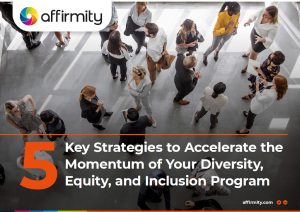Discover why companies must build an inclusive culture to retain the diverse talent that they have recruited, and how that culture has the power to attract new talent in an increasingly competitive market.
Adapted from our guide ‘5 Key Strategies to Accelerate the Momentum of Your Diversity, Equity, and Inclusion Program’, this article looks at three critical aspects of a culturally aware climate. Beginning by accounting for intersectionality and promoting allyship, we then consider how diversity training provides a crucial third pillar—one that propagates an inclusive language throughout your organization.
1) Embrace Intersectionality
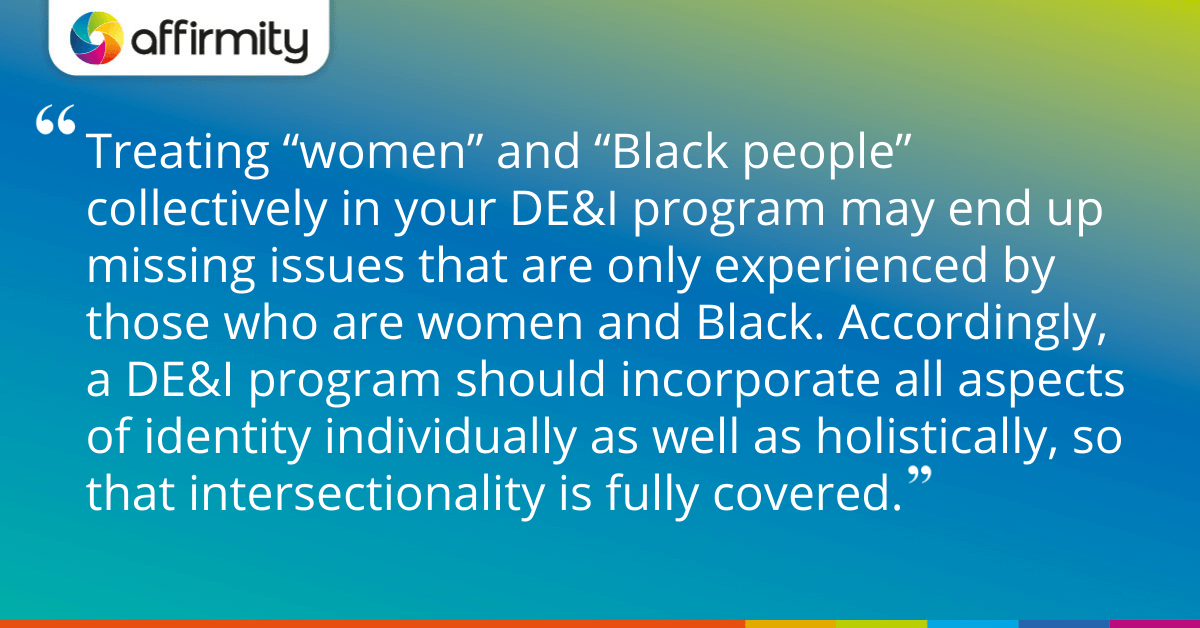
Intersectionality is the phenomenon where multiple forms of oppression have a negative effect on the working life of an individual. So it means, for example, that while a Black man makes $0.74 and a White woman makes $0.78 to a White man’s dollar, a Black woman makes only $0.64.
The oppressions intersect rather than straightforwardly combine, too.
Black women can experience issues that neither White women nor Black men encounter. One CNBC article cites an “emotional tax” on Black women, 58% of which are “always on guard to protect against bias, discrimination, and unfair treatment”. It also quotes an author and entrepreneur who felt like she couldn’t say anything about a routine of daily microaggressions “in fear of being labeled the stereotypical trope of the ‘angry Black woman’.”
In this way, treating “women” and “Black people” collectively in your DE&I program may end up missing issues that are only experienced by those who are women and Black. Accordingly, a DE&I program should incorporate all aspects of identity individually as well as holistically, so that intersectionality is fully covered.
There are, of course, many attributes that you may want to consider: not just gender and race, but sexuality, religion, socio-economic class, veteran status, and others. Robust data capture and reporting tools are required in order to make this task manageable. Nonetheless, employees are more likely to be attracted to your organization by your diversity efforts if you can demonstrate that they are nuanced and unafraid of acknowledging difference.
Read a client’s account of implementing their D&I principles: ‘How Comerica Builds Momentum in Its DE&I Strategy [Q&A]’
2) Encourage Allyship
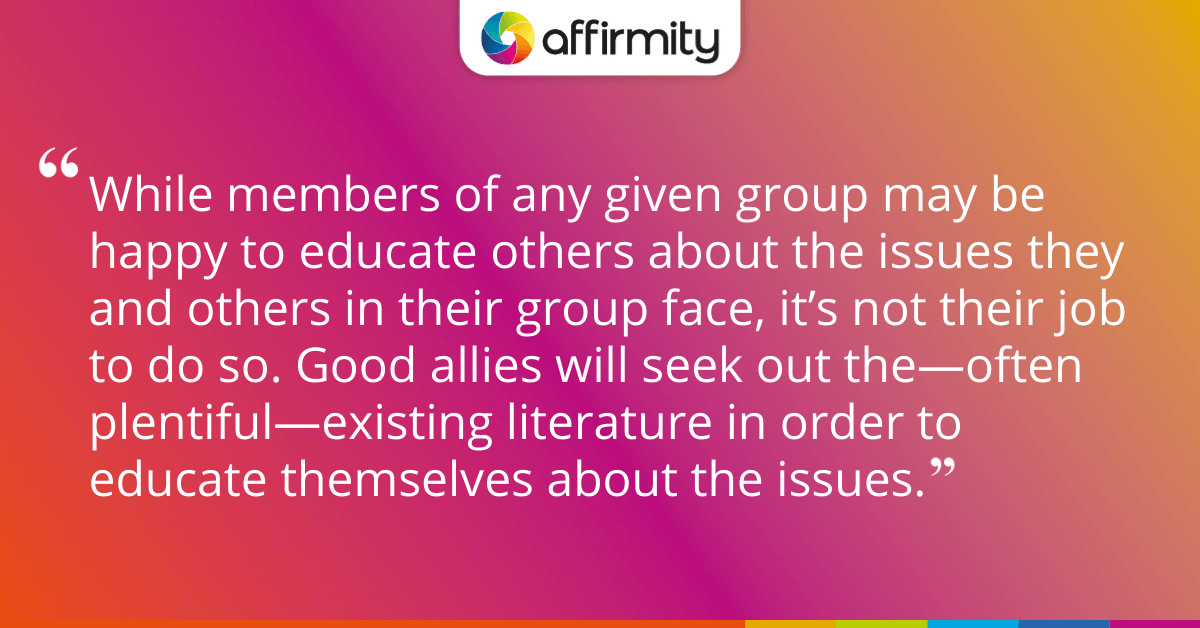
Allies in the workplace should be encouraged at all levels of management. Managers have direct responsibility for recruiting, retaining, and promoting employees, so they’re the natural starting point of allyship for diverse employees. Your DE&I program therefore needs to enable these managers (and any other willing employees) to gain appropriate knowledge and skills that will help them support and advocate for these employees.
Some attributes of good allyship (as suggested by Isla Govan’s account on diversity best practices for creating an anti-racist white caucus) that your program should aim to cultivate in employees include:
-
- Relieving the burden of education: While members of any given group may be happy to educate others about the issues they and others in their group face, it’s not their job to do so. Good allies will seek out the—often plentiful—existing literature about these issues in order to educate themselves about the issues.
- Participating, not dictating or replacing: Allies may naturally feel a certain amount of guilt when discussing historical or contemporary wrongs. This can sometimes tip over into “feeling sorry” for the group and viewing them as less fortunate and can lead to people who are nominally allies speaking for or acting on behalf of a group instead of in partnership with them.
- Being open to feedback: Good allies are allowed to make mistakes. When they do slip up, they don’t point to their track record and get defensive (saying “That’s not what I meant” or “It was just a joke”). They are open to feedback and will take an opportunity to learn from the correction.
Discover more about promoting allyship in: ‘Maximizing the Value of ERGs: Expert Answers to 7 Burning Questions’
3) Learn an Inclusive Language Through Training
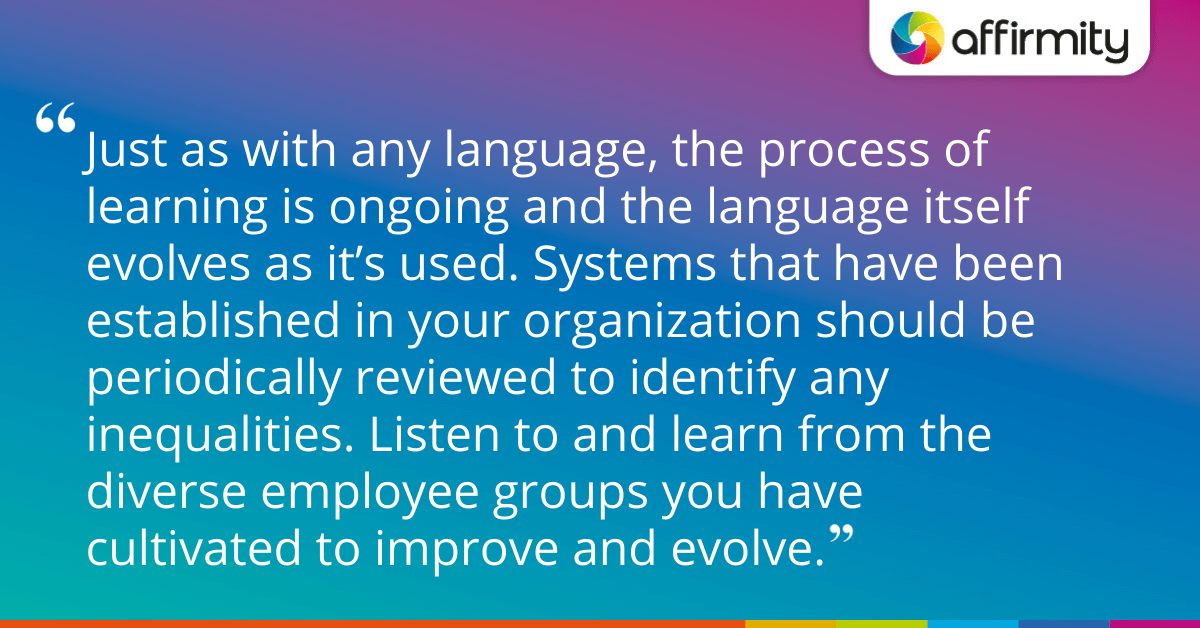
Finally, the long process of relating your message on DE&I to your employees begins with training. Your training should cover topics such as unconscious bias, microaggressions, as well as the basic principles of diversity, equity, inclusion, and respect.
You will need to deliver this training in a way that emphasizes that the principles aren’t simply academic or theoretical. Including real-world examples during your sessions is key to this approach—you can then have critical conversations to understand lived experiences and how those experiences impact an employee in the organization.
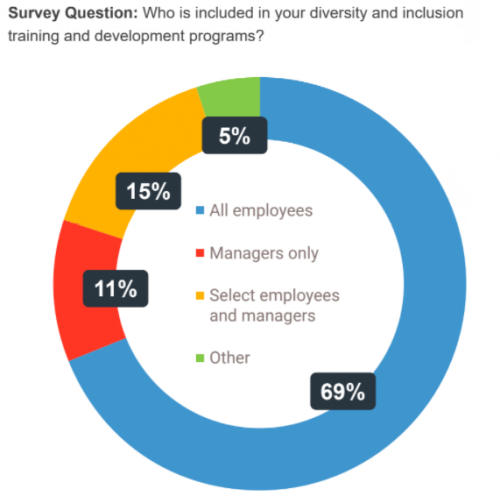
We recommend making this training as widely accessible as possible. The graph above, reproduced from the HR Research Institute’s State of Diversity and Inclusion 2019 report illustrates that the majority of businesses already conduct company-wide training. Some organizations attempt a more limited roll-out—the idea perhaps being that managers and advocates can be trained at lower cost and DE&I knowledge will trickle down.
However, as the report suggests, some organizations find that “managers are not comprehensively sharing what they learn with employees because they are not comfortable, they are too busy, or are not interested”.
It’s in the interest of organizations of all sizes to find training strategies that deliver a competitive advantage that grows over time. Ensuring your entry-level employees are also trained in aspects of DE&I and any other critical skill is one such strategy. Giving these employees access to methods such as self-guided online learning, on-the-job coaching, and virtual training is potentially more engaging, while better serving the needs of the workforce and keeping costs down.
Furthermore, these employees will take cultural knowledge as they move up the corporate ladder, and vacate a position that’s more easily filled from an HR perspective. Because DE&I-focused programs evolve the company in a positive way culturally, they’re more likely to retain the talent they’ve trained.
Exclusion has a higher cost—talent attracted away by fairer offers is expensive to repeatedly replace.
Just as with any language, the process of learning is ongoing and the language itself evolves as it’s used. Systems that have been established in your organization should be periodically reviewed to identify any inequalities. Listen to and learn from the diverse employee groups you have cultivated to improve and evolve.
More on diversity training from the archives: ‘Make Diversity Training a Competitive Advantage: 3 Topics That Can Change Behavior’
Accelerating Your DE&I Program: Continue Reading
Topics also covered in our guide include:
- The benefits of pay transparency and having a C-suite that practices what it preaches
- Why the benefits of diverse leadership and visible pay equity are underrated.
- The importance of knowing your diversity numbers and establishing regularity, benchmarking, and a greater depth of understanding of your data
Download your copy of the guide today.
